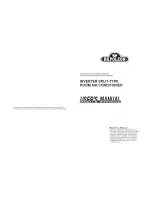
™
2.
Secure the mount foot into a sturdy surface to provide a secure base for the mount.
a) When mounting the foot to solid wood construction, use six 8 mm (5/16-in.) diameter, 25 mm (1-in.) long
hex lag screws.
b) For hollow wall or roof construction, align the foot so bolts or screws through the center holes will penetrate
a stud or rafter whenever possible (see
). Use two 8 mm (5/16-in.) diameter x 38 mm (1.5-in) long
lag screws for the center holes. When a stud or rafter cannot be found, fasten the mount foot with four
8 mm (5/16-in) diameter x 76 mm (3-in) long round head toggle bolts.
c)
When attaching the mount foot to cinder block, concrete, or brick, drill two 13 mm (1/2-in.) diameter holes
in the surface for the outside holes on each side of the foot. Insert four 8 mm (5/16-in.) diameter x
38 mm (1.5-in.) long concrete anchors.
3.
Seal the holes with caulk, RTV or roof sealer to prevent leaks.
Attaching the Mast to the Foot
1.
Position the mast (see
) so the pivot bolt holes align with the hole and slot on the foot.
2.
Align the mast so the top part of the mast is vertical (see
).
3.
Insert the two mount foot pivot bolts and tighten (see
Mounting the RTU Antenna
1.
Check the CPE Installation Worksheet to determine the antenna polarization setting for the particular customer
site.
2.
For horizontal polarization, attach the antenna clamp on the RTU antenna so the letter “H” is to the right of the
backplate as shown
. For vertical polarization, attach the antenna clamp on the RTU antenna so the
letter “V” is to the right of the backplate.
Note:
The antenna electronics package should be located at the top when the antenna is set for vertical
polarization and at the side when set for horizontal polarization.
3.
Hold the antenna assembly in place and fasten the post clamp nuts (see
Figure 2. Mount Foot Mounting
Center mounting holes
Center line
Stud or rafter under
a roof or behind a
wall





























